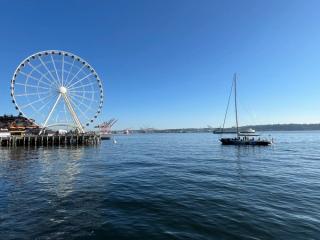
What does the GHGRP reconsideration mean for the oil and gas industry?
by Madison Edson, James Van Horne, Dr. Tecle Rufael, Selina Roman-White, Heather Matthews
View post

This is the third article in our The Journey to Nature Positive series, where our specialists illustrate how Nature-based Solutions (NbS) can tackle societal challenges, offer additional benefits over engineered solutions, and promote a Nature-positive world.
For a refresher on what we mean by Nature-based Solutions and the topics discussed in the series thus far, view:
The Journey to Nature Positive: unlocking the power of Nature-based Solutions
The Journey to Nature Positive: Integrating Freshwater Ecological Solutions in Infrastructure.
Today, we are exploring how NbS can support climate strategies by delivering holistic, ethical and effective nature-based carbon measures – and how these solutions can add value to your projects.
As the race to net zero intensifies, nature-based carbon sequestration has taken centre stage in climate strategies. To meet their net zero commitments, organisations are expected to invest in and/or directly implement projects to neutralise residual emissions (the emissions that remain after abatement)[1]. Forests, wetlands, peatlands, and other ecosystems are increasingly considered vital low-tech, scalable, long term carbon stocks and sinks with estimates suggesting that these natural climate solutions (NCS), could deliver 23% of the net emission reductions required by 2030, along with additional co-benefits. But let’s be clear - planting trees alone won’t save us. Without a step change in how we design, deliver, and measure these interventions, we risk squandering their potential, or worse, causing new harm in the name of progress.
The climate crisis and the biodiversity crisis are deeply intertwined. Addressing one without the other is short-sighted, inefficient and ultimately unsustainable. Nature-based Solutions must evolve into something more holistic, more ethical, and more effective. That means moving beyond creative carbon accounting, tree-counting PR campaigns, and business-as-usual land use. The good news? This evolution is already underway, and it's pointing us towards a more ambitious, resilient, and inclusive approach.
The early wave of nature-based solutions focused heavily on carbon sequestration, and understandably so. But this singular focus has, in many cases, sidelined biodiversity, ignored ecosystem dynamics, and undervalued social equity. When monocultures are planted for the sake of offsetting emissions, we may tick a carbon box but at the same time, lose sight of the bigger picture: the health and function of the ecosystem.
The emerging concept of “nature positive” reframes the role of nature in climate strategies. It pushes us to move from minimising harm to actively regenerating ecosystems. It means restoring the ecological functions of landscapes, empowering communities, and rebuilding resilience from the ground up. In this new paradigm, carbon sequestration (removals) is no longer considered the only objective. Quantified benefits across a range of sustainability criteria, with the UN sustainability goals in mind, are considered markers of commodity quality to those speculating.
At SLR, we believe nature positive thinking is more than a buzzword, it’s a blueprint. Whether it's restoring peatlands, rewilding post-industrial sites, or designing multifunctional agricultural landscapes, our teams bring together ecological science, planning expertise, and stakeholder insight to embed climate, biodiversity, and community goals from the outset.
There’s no question: we need to scale nature-based carbon sequestration at unprecedented speed. But scale without integrity is a false solution. Across the world, we’re already seeing the risks: land grabs that displace local communities, cookie-cutter projects that ignore ecological context, and corporate offset schemes that look good on paper but falter in the real world.
True climate leadership demands more. Scaling must go hand-in-hand with safeguards for biodiversity, for people, and for future generations. That means inclusive project design, rigorous baseline assessments, transparent governance, and adaptive management. It also means listening to those who live closest to the land.
The best examples of nature-based carbon sequestration today are not those that remove the most atmospheric carbon quickest but those that endure, evolve, and create shared value. Projects that weave together local knowledge and engagement, ecological intelligence, and long-term vision are not only more ethical, but they’re also more resilient and more impactful.
Our interdisciplinary teams are supporting clients to scale responsibly through combining ecology, Environmental, Social, Governance (ESG), carbon accounting/greenhouse gas estimation, and community engagement to ensure projects deliver real value, not just volume. It’s not just about doing more; it’s about doing it right.
Tree planting has become the poster child of nature-based solutions, and while trees are vital, they’re not a silver bullet. Fast-growing monocultures may sequester carbon in the short term, but they can undermine soil health, reduce water availability, and displace native biodiversity. Worse, they can fail entirely if not properly designed and maintained. Although there is seemingly a consensus in the public mindset that planting trees will solve all our problems, we simply do not have sufficient spare land for the number of trees needed to sequester carbon in the volumes required to avert the climate crisis[2].
What we need is true ecological restoration, the kind that revives natural processes, supports native species, and restores the balance between people and the environment. This means mixed-species plantings, wetland rewilding, regenerative agriculture, and more. It means thinking beyond antiquated narratives over emissions, air quality and carbon curves, and towards ecosystem functionality: hydrology, pollination, nutrient cycling, climate resilience.
Restoration isn’t easy, quick, or cheap but it’s essential. And when done well, it delivers long-term carbon storage, climate adaptation benefits, and tangible gains for nature and communities alike.
Our team of specialists support clients across the full lifecycle of restoration from feasibility and site selection to implementation and monitoring. We help clients shift the focus from tree counts to ecosystem health indicators and we bring the scientific and strategic rigour needed to make that shift meaningful.
As the climate crisis deepens, there’s a real temptation to pursue the fastest, easiest, and most marketable solutions. But carbon sequestration is not a game of speed or optics. It’s a long game, one that demands patience, humility, and a commitment to doing things properly.
That’s why we believe nature-based carbon sequestration must mature beyond its early stages. It must become more than a mitigation tool and instead, become a force for regeneration, equity, and resilience.
Funders and policymakers must reward quality over quantity. Project developers must design with biodiversity and people in mind. And businesses must embrace multi-metric success not just carbon credits, but ecosystem health, social value, and climate adaptation.
The future of carbon sequestration doesn’t lie in planting more trees, it lies in restoring more ecosystems. It lies in projects that are grounded in science, rooted in place, and designed with care. It must be achieved via projects that provide additionality and generate long-term carbon storage. Our specialists are proud to walk this path with clients who strive to go beyond offsetting – those committed to making lasting, positive impact.
NbS provide a significant opportunity to accelerate sustainable approaches to addressing climate change. Delivering on this ambition will require specialists (including aquatic ecologists, hydrologists, hydrogeologists, engineers, soil scientists, economists, social scientists, and climate scientists) collaborating to plan, design and implement schemes that work and integrate with primary project outcomes.
Our team offer comprehensive ecology, and biodiversity services globally. They can support your organisation with governance and strategy advice, as well as operational project support to incorporate NbS at all stages of infrastructure developments.
To speak with one of our specialists, contact Kate, Ida or Caroline today.
Our next article in the series will focus on methods for sampling and quantifying nature and biodiversity for large and dispersed projects.
Read moreReferences

by Madison Edson, James Van Horne, Dr. Tecle Rufael, Selina Roman-White, Heather Matthews

by Jonathan Vallarta

by Dane Ancheta